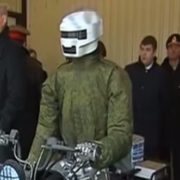 Wintergreen Research is publicizing a finding that the “…first responder and military ground robot marketplace will expand at close to 20% annually for the rest of the decade.” Furthermore, “Markets at $4.5 billion in 2013 reach $12.0 billion by 2019.”
Wintergreen Research is publicizing a finding that the “…first responder and military ground robot marketplace will expand at close to 20% annually for the rest of the decade.” Furthermore, “Markets at $4.5 billion in 2013 reach $12.0 billion by 2019.”
This is welcome news for the developers of Unmanned Ground Vehicles (UGV). Robohub points out that this projection is consistent with a Markets and Markets report that predicts a 17.4% CAGR for the same time period. Of course, any headline in the media must be greeted with a certain degree of skepticism. Do these projections make sense?
I am very bullish about the long-term prospects for UGVs. As I wrote in UGVs & UAVs in domestic markets, I expect UGVs (and their subsystems) to be in demand for healthcare, agriculture, telepresence, logistics, transport, and above all, autonomous automobiles. While these applications may undergo tremendous growth, I don’t expect any of them to become so widespread in the next six years as to cause a 20% annual market increase.
Evidently, neither does Wintergreen. They mention some of these markets, but they predict UGV’s phenomenal growth to be fueled primarily by military, First responder, and security applications. This runs against conventional wisdom that the military demand for UGVs will decrease because of the winding down of land wars, as well as the “China pivot,” which emphasizes air and sea forces.
Wintergreen expects fear of terrorism to be the driving force behind the demand for UGVs. “While the Army’s committed to unmanned ground systems, appears to be slowing, this commitment is anticipated to heat up again quickly. The investment priorities are anticipated to change as the Defense Department realizes that investments in ground robots are needed to fight terrorism everywhere.”
Furthermore, argues Wintergreen, police and other security agencies will want their very own UGVs to combat terror. Of course, the problem with this line of thinking is that many military UGVs are being refitted for civilian use.
“The Army plans to upgrade 2,700 of its existing military robot systems for use in training or further deployments…Another 2,469 will be divested and given to Defense Department partners or other government agencies.” (Wintergreen)
Why buy a new UGV when you can get a battlefield-tested one virtually for free from the government? At last year’s Ground Robotics Capabilities Conference, a developer told me he was worried about depressed demand for UGVs precisely because of the government give-away.
Another developer argued that this was a baseless fear; many UGVs are damaged in combat conditions, so they can’t be recycled. Also, police and other First Responders may prefer the newer generations of UGVs, such as the diminutive Throwbot and FirstLook. They may be willing to pay for a UGV that fits their needs, instead of being satisfied with an older free model that doesn’t meet their requirements.
No matter how you look at it, 2,469 is a lot of used UGVs to throw at the emerging civilian market. Just how many UGVs do police and other security agencies really need?
Of course, need is not the same thing as want. The Wintergreen report cites the recent Boston Bombing as a factor in increasing concerns about terrorism. Politicians may spur UGV funding for anti-terror activities at a level that is not warranted by the actual danger.
UGV adoption may parallel the proliferation of SWAT teams. Some observers have questioned the wisdom of the generous Federal programs that have spurred the formation of these elaborately outfitted “militarized” squads. The number of SWAT teams, they argue, is not proportional to society’s actual need, especially in small police jurisdictions.
We can already see similar dynamics in the spread of unmanned systems. A rather extreme example of this is the Alabama sheriff who discovered that his department had UAVs for two years, and he didn’t know about it. When asked to explain how he could overlook two expensive UAVs, the sheriff replied that there simply had never been an occasion in which his department needed the UAVs. If the sheriff had to pay for the two UAVs (value: $150,000) out of his own department’s budget, instead of relying on Federal subsidies, I suspect he would have notice their presence in his inventory. Government programs, especially counter-terror ones, may create analogous situations in the UGV market.
Keep in mind, Wintergreen’s “$12.0 billion by 2019” projection is for the entire world, not just the US. The US Defense budget for land forces may be shrinking in (and that’s far from certain), but other countries, such as the Gulf states, and India are going on military spending sprees. Even European countries that are bucking the global trend by slashing their military budgets, may spring for UGVs. After all, they are also worried about terror, and they have a long way to go before they match our unmanned capabilities.
One factor that is impossible to estimate is our terrible track record of predicting what we will need for the next war. The “China Pivot” may turn out to be completely irrelevant. For example, the US military is increasingly involved in Africa, a theater that could drive up the demand for UGVs.
UGV market growth is an important to AMREL. We make Operator Control Units (OCUs) for the PackBot, MARCBot, FirstLook, as well as half (or more) of UGVs used in theater. AMREL is the only developer that has OCUs deployed in UGVs built by many different manufactures. We will follow this issue very closely and keep you informed as developments arise.







